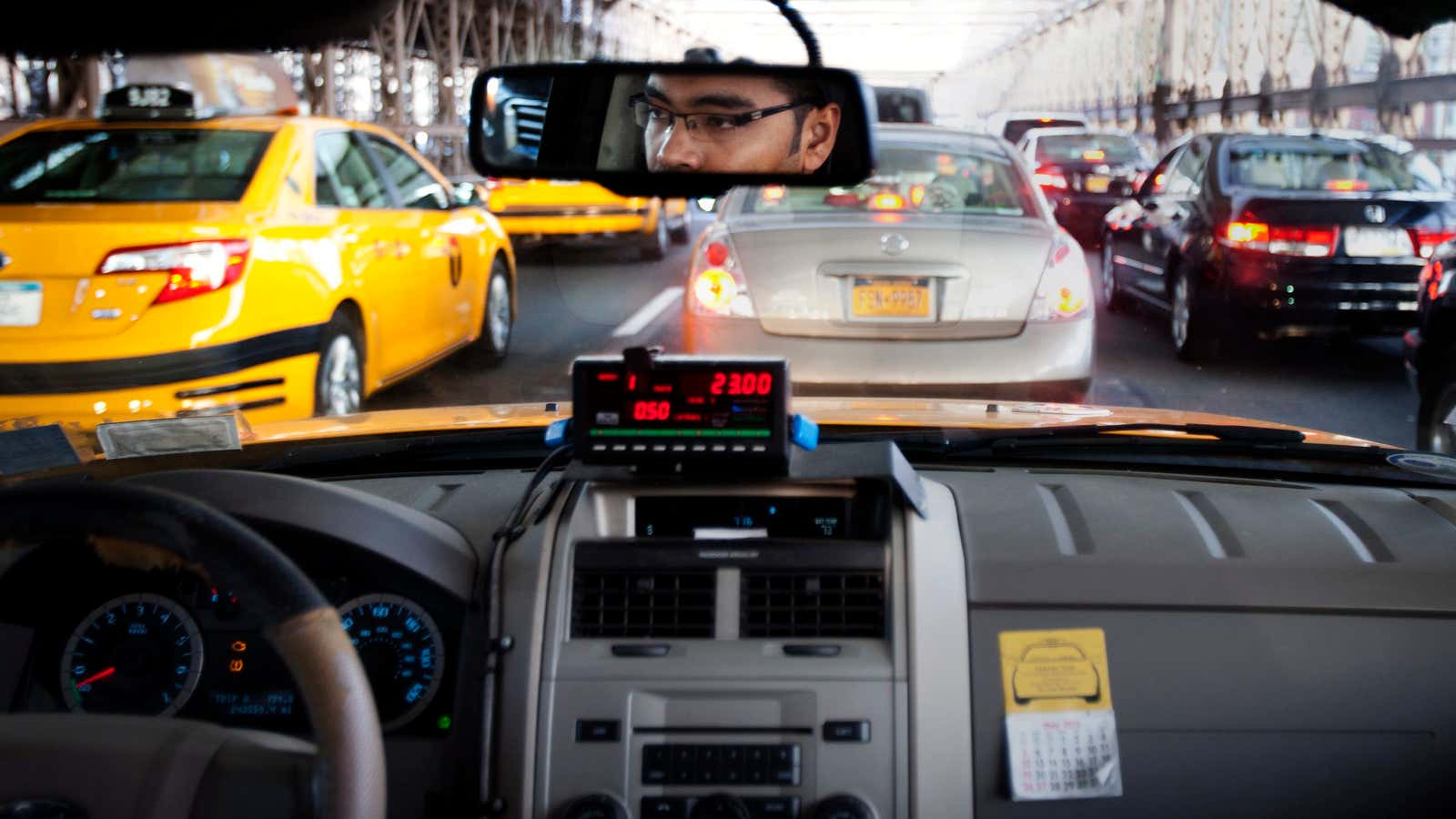This post has been corrected.
A new analysis suggests that Uber could be playing a significant role in New York City’s worsening traffic congestion—but it also shows that the response proposed by city officials is unlikely to alleviate the problem.
Uber, Lyft, and other businesses that run app-based car services in New York City are facing a year-long freeze on new cars proposed by mayor Bill de Blasio and members of the city council. The freeze would be implemented in order to perform a study of why average driving speeds in the city center dropped by 9% between 2010 and 2014, to just 8.5 miles per hour. Uber says that its business model is being unfairly blamed for gridlock, and that the real motivation for the freeze is the political power of its competitors in the traditional taxi industry.
But a model meant to compare the benefits of different transportation plans (it was developed by Charles Komanoff, a policy analyst and transit activist) shows that adding some 20,000 new for-hire vehicles to city streets could reduce speeds in central Manhattan by as much as 6.7%—the equivalent of $500 million annually in lost time for drivers and passengers.
So let’s look more closely.
Komanoff’s model—which he calls the “Balanced Transportation Analyzer”—is a complicated spreadsheet (xls) that attempts to balance out the numerous factors that affect New York City traffic: Public transportation, private cars, hired cars, walkers, bikers, tolls, you name it. He built it to help convince people that congestion pricing—charging cars more than the usual toll to go into the center of the city—will reduce gridlock and create a new revenue stream to fund improvements to public transit.
It’s a classic attempt to put a price on an abused public good, akin to a carbon tax, and it’s almost as controversial. A push by former mayor Mike Bloomberg failed due to objections from the populace surrounding the city, but Komanoff and others in the Move NYC coalition have come up with a revamped plan they say is more palatable to people outside the city limits. According to the model, it would generate $2.5 billion in net benefits to the city.
The same benchmark used in calculating the effects of this plan can also, in a roundabout way, model the addition of new Uber and Lyft cars driving in Manhattan. Komanoff uses publicly available estimates of Uber driver activity—some provided by the company itself—to estimate how many additional vehicle miles are driven in the central business district, thus generating the 6.7% drop in speed.
However, he notes that is a top limit—at least some of the cars providing Uber and Lyft trips are likely to be existing livery or taxi cabs, which means they are double-counted by the 6.7%. “There’s a big ‘if,'” he says. “That’s an empirical question that has to be answered by people really looking at taxi records, seeing how many fewer taxi trips there are.”
Despite the haziness, Komanoff says he believes that Uber has significantly contributed to congestion. But he doesn’t think that capping the number of for-hire vehicles is the clear way to fix a problem with perhaps half a dozen causes. The latter sentiment is something that even Uber can get behind.
“There are unquestionably many different variables that could and are contributing to congestion, which is a historic problem in New York City going back decades, well before Uber came here,” Matthew Wing, an Uber spokesperson, tells Quartz. ”What is troubling is that the administration is taking the unprecedented step of capping just for-hire vehicle growth, most notably impacting Uber, and ignoring other factors. They should look at a holistic solution and not blame technology, which can play a real part in solving the problem.”
Uber notes that overall the same period in which the fall in traffic speed was measured, the city decreased Manhattan speed limits, added 366 miles of bike lanes, and created new public plazas and slow-speed zones. And then there is the city’s increasingly crowded subway system, which may lead straphangers who can afford it turning to car services instead.
Ultimately, it seems the problem isn’t really Uber—it is New Yorkers themselves, and their government’s failure to build a functioning transit market.
“People make a decision that is rational for themselves, to pass up the subway and use their phone-based app and grab a for-hire vehicle,” Komanoff says. “Everybody’s utility function doesn’t include the congestion that their choice of motor vehicle is imposing on everyone else.”
Correction (July 13): An earlier version of this article misstated the cost estimate of New Yorkers’ lost time due to additional for-hire vehicles in the city; the correct estimate is $500 million.
